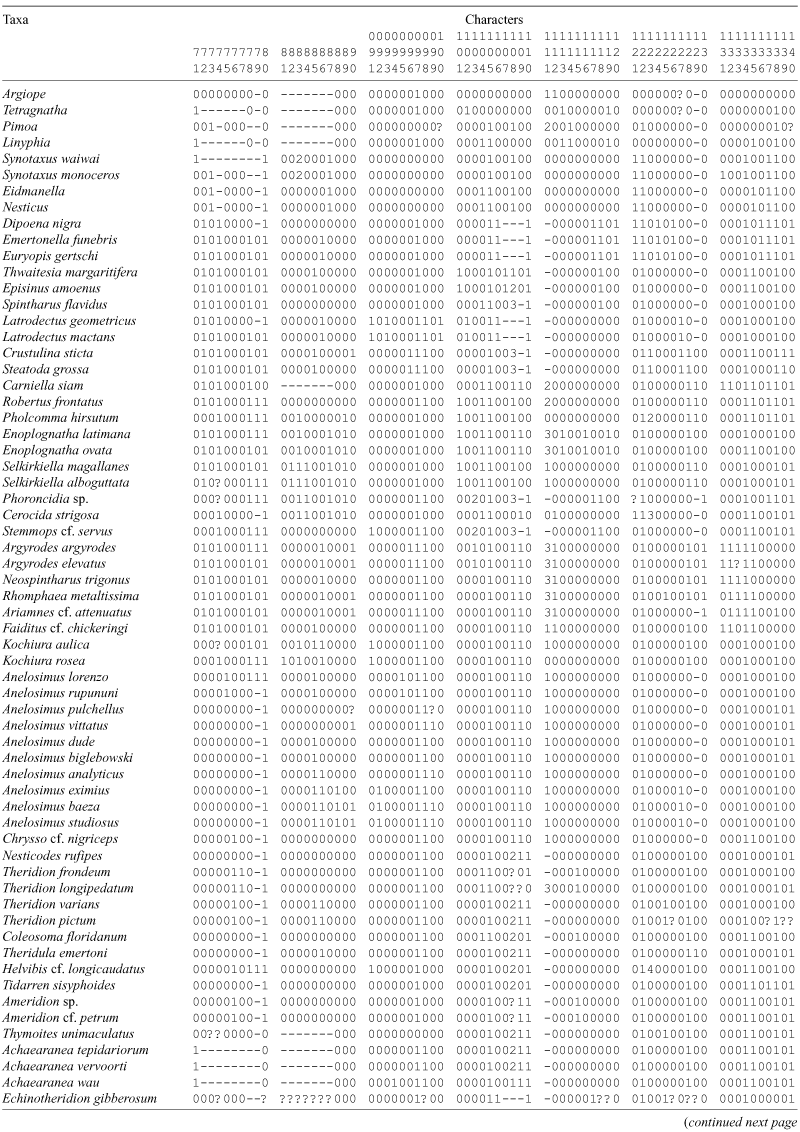Phylogenetic placement of Echinotheridion (Araneae : Theridiidae) – do male sexual organ removal, emasculation, and sexual cannibalism in Echinotheridion and Tidarren represent evolutionary replicas?
Ingi AgnarssonA The University of British Columbia, Departments of Botany and Zoology, #3529-6270 University Blvd., Vancouver, BC V6T 1Z4, Canada.
B Department of Entomology, Smithsonian Institution, NHB-105, PO Box 37012, Washington, DC 20013-7012, USA.
C Email: ingi@zoology.ubc.ca, ingi@theridiidae.com
Invertebrate Systematics 20(4) 415-429 https://doi.org/10.1071/IS05043
Submitted: 26 September 2005 Accepted: 2 June 2006 Published: 29 August 2006
Abstract
Uniquely among spiders, males of two cobweb spider (Theridiidae) genera, Tidarren Chamberlin & Ivie, 1934 and Echinotheridion Levi, 1963, voluntarily amputate one of their secondary sexual organs (the pedipalpi, modified as sperm transfer organs) before their last molt and thus have only one palp as adults. This is the first step in a fascinating sexual biology observed in both genera, which is marked by sexual dimorphism – males are tiny compared with females – and usually involves both emasculation and sexual cannibalism. To study the evolution of these striking traits it is essential to understand the phylogenetic relationship of these genera. Both morphological and molecular data place Tidarren in the subfamily Theridiinae. However, Echinotheridion has not been placed phylogenetically to date owing to rarity of specimens, and difficulty of interpreting the highly autapomorphic palpal organ, the main source of morphological characters. Here, the phylogenetic position of Echinotheridion is inferred using fragments of three nuclear (Histone 3, 18S rDNA, and 28S rDNA) and two mitochondrial (16S rDNA and COI) loci. Each matrix separately, and a combined matrix, were analysed using parsimony with gaps either treated as missing data, or as 5th state, and with Bayesian methods. Although all genes agree that Tidarren and Echinotheridion are closely related, perhaps surprisingly, none of the analyses supported their sister relationship. The sister relationship was ambiguously supported in a preliminary morphological analysis, whereas combined molecular and morphological data refuted it. This implies a more complex evolutionary history of male sexual organ removal and other bizarre sexual biology of Tidarren and Echinotheridion than previously envisioned. Many of the analyses are equally consistent with two hypotheses: a single origin, followed by a secondary loss; or independent evolution of this behaviour in the two genera. However, based on the combined molecular Bayesian phylogeny, and some of the preliminary ‘total evidence’ analyses, the latter hypothesis is better supported.
Additional keywords: cobweb spiders, palpal amputation, theridiid phylogeny.
Acknowledgments
Thanks to Matjaž Kuntner, Jun-Xia Zhang, Laura May-Collado, Camilla Myers and two anonymous reviewers for helpful comments on a version of the manuscript. Research and collecting permits in Ecuador were obtained through the Instituto Ecuatoriano de Areas Protegidas y Vida Silvestre, with the sponsorship of the Museo Ecuatoriano de Ciencias Naturales and the Department of Biology of the Pontificia Universidad Católica del Ecuador. Support for this research came from NSERC grants to Leticia Avilés and Wayne P. Maddison, and a Killam Postdoctoral Fellowship to I. Agnarsson.
Agnarsson I.
(2003) The phylogenetic placement and circumscription of the genus Synotaxus (Araneae: Synotaxidae) with a description of a new species from Guyana, and notes on theridioid phylogeny. Invertebrate Systematics 17, 719–734.
| Crossref | GoogleScholarGoogle Scholar |
for detailed descriptions)




|

|

|

|


